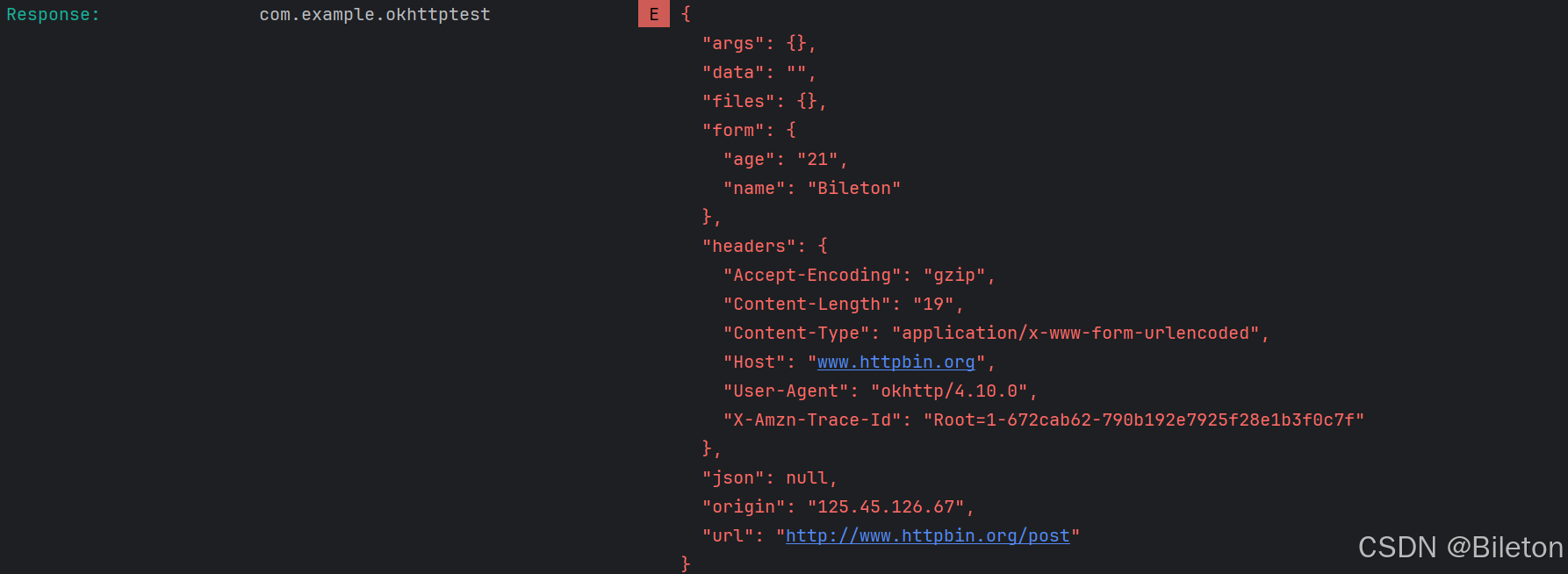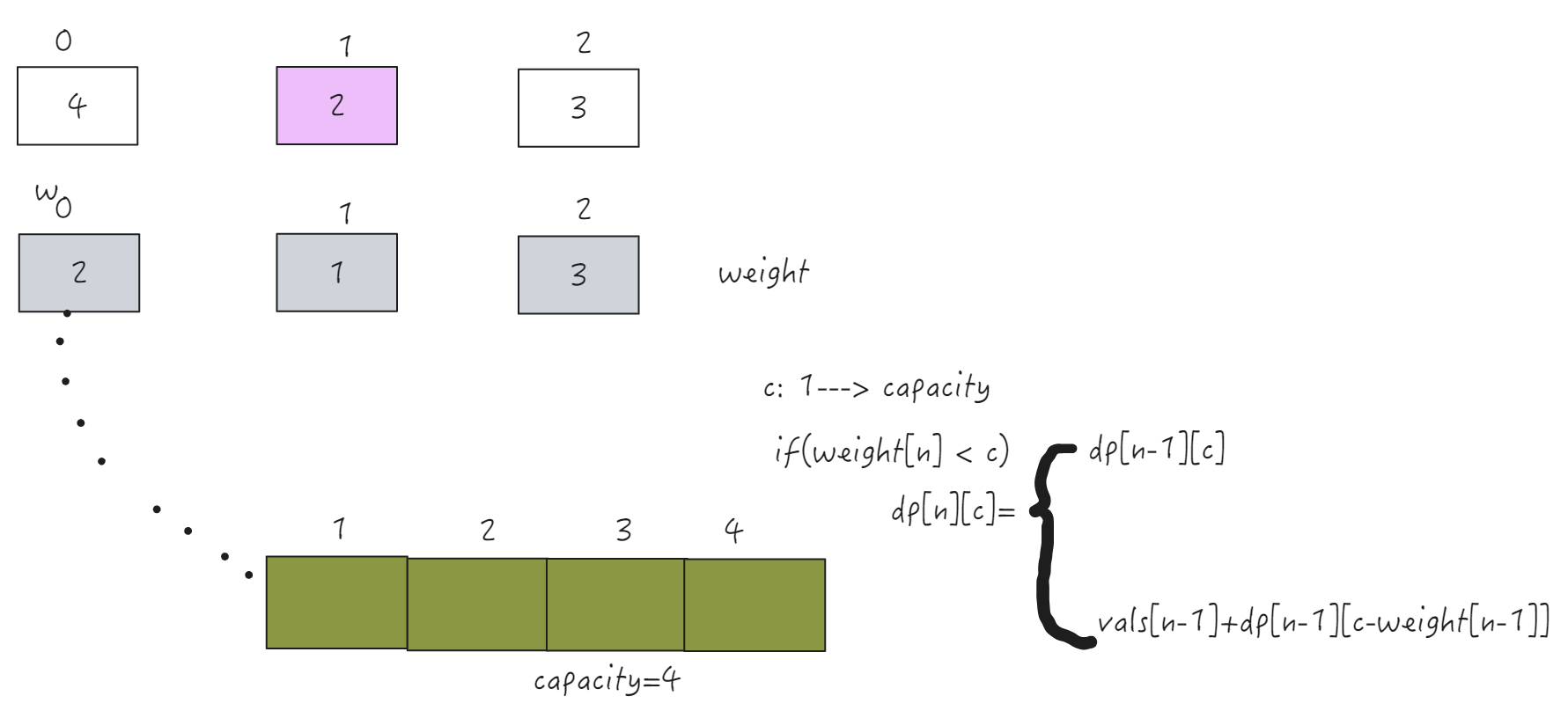添加依赖
在 build.gradle 文件中添加 OkHttp 依赖:
dependencies {implementation("com.squareup.okhttp3:okhttp:4.10.0")
}
使用OkHttp发起GET请求
同步请求
public class MainActivity extends AppCompatActivity {// Used to load the 'okhttptest' library on application startup.static {System.loadLibrary("okhttptest");}private ActivityMainBinding binding;@Overrideprotected void onCreate(Bundle savedInstanceState) {super.onCreate(savedInstanceState);binding = ActivityMainBinding.inflate(getLayoutInflater());setContentView(binding.getRoot());// Example of a call to a native methodTextView tv = binding.sampleText;tv.setText(stringFromJNI());new Thread(new Runnable() {@Overridepublic void run() {// 创建 OkHttpClientOkHttpClient client = new OkHttpClient();// 创建 Request 对象Request request = new Request.Builder().url("https://www.httpbin.org/get") // URL.build();// 同步请求try (Response response = client.newCall(request).execute()){if(response.isSuccessful()){String responseBody = response.body().string(); // 读取响应体Log.d("Response:",responseBody);// 在主线程中显示 ToastrunOnUiThread(new Runnable() {@Overridepublic void run() {// 显示 ToastToast.makeText(MainActivity.this, responseBody, Toast.LENGTH_SHORT).show();}});}else {Log.e("Request failed", String.valueOf(response.code()));}} catch (IOException e) {throw new RuntimeException(e);}}}).start();}public native String stringFromJNI();
}

异步请求
public class MainActivity extends AppCompatActivity {// Used to load the 'okhttptest' library on application startup.static {System.loadLibrary("okhttptest");}private ActivityMainBinding binding;@Overrideprotected void onCreate(Bundle savedInstanceState) {super.onCreate(savedInstanceState);binding = ActivityMainBinding.inflate(getLayoutInflater());setContentView(binding.getRoot());// Example of a call to a native methodTextView tv = binding.sampleText;tv.setText(stringFromJNI());new Thread(new Runnable() {@Overridepublic void run() {// 创建 OkHttpClientOkHttpClient client = new OkHttpClient();// 创建 Request 对象Request request = new Request.Builder().url("https://www.httpbin.org/get") // URL.build();// 同步请求client.newCall(request).enqueue(new Callback() {@Overridepublic void onFailure(@NonNull Call call, @NonNull IOException e) {Log.e("Request failed: ",e.getMessage());}@Overridepublic void onResponse(@NonNull Call call, @NonNull Response response) throws IOException {String ResponseBody = response.body().string();if (response.isSuccessful()){Log.e("Response: " ,ResponseBody);runOnUiThread(new Runnable() {@Overridepublic void run() {Toast.makeText(MainActivity.this,ResponseBody,Toast.LENGTH_SHORT).show();}});}else {Log.e("Request failed:",String.valueOf(response.code()));}}});}}).start();}public native String stringFromJNI();
}

POST请求
允许通过HTTP访问网络资源,Android 默认禁止应用使用非加密(HTTP)通信,以保护用户数据的安全。默认情况下,Android 9(API 级别 28)及更高版本需要通过 HTTPS 进行网络通信。
通过修改AndroidManifest.xml文件来临时允许明文HTTP流量。
<applicationandroid:usesCleartextTraffic="true"...</application>
发送请求
public class MainActivity extends AppCompatActivity {// Used to load the 'okhttptest' library on application startup.static {System.loadLibrary("okhttptest");}private ActivityMainBinding binding;@Overrideprotected void onCreate(Bundle savedInstanceState) {super.onCreate(savedInstanceState);binding = ActivityMainBinding.inflate(getLayoutInflater());setContentView(binding.getRoot());// Example of a call to a native methodTextView tv = binding.sampleText;tv.setText(stringFromJNI());new Thread(new Runnable() {@Overridepublic void run() {// 创建 OkHttpClientOkHttpClient client = new OkHttpClient();RequestBody formBody = new FormBody.Builder().add("name","Bileton").add("age","21").build();// 创建 Request 对象Request request = new Request.Builder().url("http://www.httpbin.org/post") // URL.post(formBody).build();// 同步请求client.newCall(request).enqueue(new Callback() {@Overridepublic void onFailure(@NonNull Call call, @NonNull IOException e) {Log.e("Request failed: ",e.getMessage());}@Overridepublic void onResponse(@NonNull Call call, @NonNull Response response) throws IOException {String ResponseBody = response.body().string();if (response.isSuccessful()){Log.e("Response: " ,ResponseBody);runOnUiThread(new Runnable() {@Overridepublic void run() {Toast.makeText(MainActivity.this,ResponseBody,Toast.LENGTH_SHORT).show();}});}else {Log.e("Request failed:",String.valueOf(response.code()));}}});}}).start();}public native String stringFromJNI();
}

拦截器
OkHttp 的拦截器是一个非常强大的工具,可以在请求和响应过程中拦截和修改 HTTP 请求和响应。拦截器可以用于日志记录、修改请求/响应、添加通用头部信息、缓存等功能。
OkHttp提供了两种类型的拦截器:
-
应用拦截器(Application Interceptor)
应用拦截器可以在请求被发送之前或响应到达客户端之后进行拦截。应用拦截器不会直接影响网络层操作。OkHttpClient client = new OkHttpClient.Builder().addInterceptor(new Interceptor() {@Overridepublic Response intercept(Chain chain) throws IOException {Request originalRequest = chain.request();// 添加头部信息Request modifiedRequest = originalRequest.newBuilder().header("Authorization", "Bearer your_token").build();// 继续链条中的下一个拦截器return chain.proceed(modifiedRequest);}}).build(); -
网络拦截器(Network Interceptor)
网络拦截器更接近网络层,能访问和修改在网络上传输的数据。它们可以用来实现诸如缓存和压缩的功能。OkHttpClient client = new OkHttpClient.Builder().addNetworkInterceptor(new Interceptor() {@Overridepublic Response intercept(Chain chain) throws IOException {Request request = chain.request();// 打印请求信息long startTime = System.nanoTime();System.out.println(String.format("Sending request %s on %s%n%s",request.url(), chain.connection(), request.headers()));Response response = chain.proceed(request);// 打印响应信息long endTime = System.nanoTime();System.out.println(String.format("Received response for %s in %.1fms%n%s",response.request().url(), (endTime - startTime) / 1e6d, response.headers()));return response;}}).build();
在请求中使用拦截器
OkHttpClient client = new OkHttpClient.Builder().addInterceptor(new CustomInterceptor()) // 添加应用拦截器.addNetworkInterceptor(new CustomNetworkInterceptor()) // 添加网络拦截器.build();Request request = new Request.Builder().url("https://www.example.com").build();client.newCall(request).enqueue(new Callback() {@Overridepublic void onFailure(Call call, IOException e) {e.printStackTrace();}@Overridepublic void onResponse(Call call, Response response) throws IOException {if (response.isSuccessful()) {System.out.println(response.body().string());}}
});

















